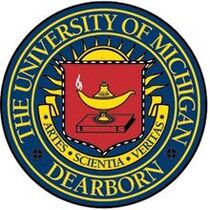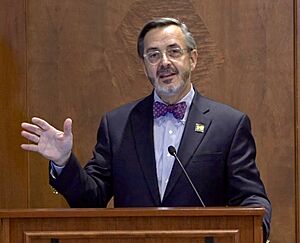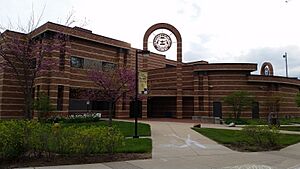University of Michigan–Dearborn facts for kids
 |
|
|
Former names
|
Dearborn Center of the University of Michigan (1959–1963) Dearborn Campus of the University of Michigan (1963–1971) |
|---|---|
| Motto | Arts, Knowledge, Truth |
| Type | Public university |
| Established | 1959 |
|
Parent institution
|
University of Michigan Board of Regents |
| Accreditation | HLC |
|
Academic affiliation
|
CUMU |
| Endowment | $77.4 million (2021) |
| Budget | $192 million (2022-23) |
| Chancellor | Gabriella Scarlatta (interim) |
| President | Domenico Grasso (interim) |
| Provost | Gabriella Scarlatta |
|
Academic staff
|
511 |
| Students | 8,224 |
| Undergraduates | 6,117 |
| Postgraduates | 1,982 |
| 125 | |
| Location |
,
Michigan
,
United States
|
| Campus | Suburban 200+ acres |
| Newspaper | The Michigan Journal |
| Colors | Maize & Blue |
| Nickname | Wolverines |
|
Sporting affiliations
|
NAIA – WHAC |
 |
|
The University of Michigan–Dearborn (UM-Dearborn) is a public university in Dearborn, Michigan. It started in 1959 with a special gift from the Ford Motor Company. At first, it was called the Dearborn Center and was a branch of the University of Michigan.
In 1970, it became its own university and changed its name to the University of Michigan–Dearborn. It still follows the rules of the University of Michigan Board of Regents. UM-Dearborn is known for its research and for being involved in the local community.
The university's sports teams are called the Michigan-Dearborn Wolverines. They play in the Wolverine–Hoosier Athletic Conference. The University of Michigan-Dearborn Fieldhouse is where the basketball teams play. Many successful people have studied here, including business leaders and politicians.
Contents
History of the University
How UM-Dearborn Started
The idea for UM-Dearborn began in the mid-1950s. Archie Pearson, who worked at Ford Motor Company, realized that Ford would need more college-educated engineers and managers in the future. He looked for universities in the Detroit area that could help train these future workers.
On December 17, 1956, the Ford Motor Company gave land and money to the Regents of the University of Michigan. This gift was for a new branch of the university in Dearborn. This branch would offer advanced college classes and master's degrees.
In February 1957, the University of Michigan officially accepted the gifts. They decided to create the Dearborn Center of the University of Michigan. This new center would also have a special work-study program. Students would get real-world experience, which would help them find jobs after graduation.
Construction on the Dearborn Center began in May 1958. William E. Stirton became its first director. The branch opened on September 28, 1959, with 34 students. More programs, like liberal arts and teacher education, were added in 1960. The first students graduated in 1962. In 1963, the branch was renamed the Dearborn Campus of the University of Michigan. This new name showed it was a separate part of the university.
In 1969, a committee suggested adding classes for first and second-year students. The university leaders approved these changes.
Becoming an Independent University
In February 1970, there was a discussion about making the Dearborn campus a completely separate university. It was suggested to call it "Fairlane University." However, students and teachers at Dearborn did not want this to happen, so the idea failed.
Even though it didn't become fully independent, the Dearborn campus continued to grow. It received its own official approval (accreditation) in August 1970. In April 1971, it was officially renamed the University of Michigan–Dearborn. It still remained connected to the University of Michigan.
Leadership and Growth (1971-1979)
In August 1970, UM-Dearborn received its first accreditation, separate from the Ann Arbor campus. In April 1971, it was officially renamed. In July 1971, Leonard E. Goodall became UM-Dearborn's first chancellor. In the fall of 1971, the university welcomed its first class of freshmen, becoming a four-year school. Student numbers grew quickly, reaching over 6,000 by 1979.
Between 1978 and 1980, three important new buildings opened: the Fieldhouse and Ice Arena, the University Library, and the University Mall. These new buildings helped the campus grow.
Challenges and New Programs (1980-1988)
In July 1980, William A. Jenkins became the second chancellor. He faced money problems due to a state recession. Despite this, new programs were started. In 1981, a history professor created the Holocaust Survivor Oral History Project. In 1986, UM-Dearborn opened its Armenian Research Center, the first of its kind at a university.
Changes in Sports and Enrollment (1988-1992)
In November 1988, Blenda Wilson became the third chancellor. The university started a big renovation project. In 1990, the university changed its ice hockey program to a club sport. Basketball and women's volleyball teams began competing in the National Association of Intercollegiate Athletics (NAIA). By 1991, more than 1,000 graduate students were enrolled.
Continued Growth and New Ideas (1993-1999)
In January 1993, James C. Renick became the fourth chancellor. The university reached new student enrollment records in 1995 and 1996. In 1997, the College of Arts, Sciences, & Letters (CASL) started its first graduate program. In 1999, a planning group suggested that UM-Dearborn should aim to be a top regional university.
Expanding Programs and Facilities (2000-2018)
In November 2000, Daniel E. Little became the fifth chancellor. New buildings like the Environmental Interpretive Center and the CASL Building opened in 2001. By 2003, student enrollment reached over 9,000. The university also bought the Fairlane Training Center from Ford.
In 2008, UM-Dearborn started its first doctoral programs (Ph.D. degrees) in engineering. In 2009, the School of Management became the College of Business. In 2013, the first on-campus student housing opened. The Natural Sciences Building was renovated in 2016. Daniel E. Little resigned as chancellor in 2018.
Recent Leadership (2018-Present)
In August 2018, Domenico Grasso became the university's sixth chancellor. In May 2025, Domenico Grasso was chosen to be the interim President of the University of Michigan in Ann Arbor. Gabriella Scarlatta, who was the provost at UM-Dearborn, became the interim chancellor.
Campus Life and Environment
The UM-Dearborn campus is on land that used to belong to Henry Ford. It has several parts: The Henry Ford Estate (called Fair Lane), The Fairlane Center, the Main Campus, and the Early Childhood Education Center.
The university also has over 70 acres of nature preserve. There is a bird observatory, the Rouge River Bird Observatory, which has been on campus since 1992. It is the longest-running urban bird research station in North America.
The Main Campus has buildings for the College of Arts, Sciences, and Letters (CASL), the College of Engineering and Computer Science (CECS), the Environmental Interpretive Center, the Mardigian Library, and the University Center.
Fair Lane and the nature preserve are along the Rouge River. There is a small waterfall, a rose garden, and walking paths. These paths connect the campus to other areas like Henry Ford Community College. Fair Lane is now managed by the Edsel and Eleanor Ford House, which is working to restore it.
How the University is Organized
Leadership and Management
UM-Dearborn has always been part of the University of Michigan. It follows the rules set by the Board of Regents of the University of Michigan. The Board of Regents chooses the university president. The president then suggests a chancellor for UM-Dearborn, who manages the daily activities of the university.
List of Chancellors
- Leonard E. Goodall (1971–1979)
- William A. Jenkins (1980–1988)
- Blenda J. Wilson (1988–1992)
- James C. Renick (1993–1999)
- Bernard W. Klein (acting/interim at different times)
- Daniel E. Little (2000–2018)
- Domenico Grasso (2018–2025)
- Gabriella Scarlatta (2025–present, interim)
University Departments
UM-Dearborn has four main colleges:
- The College of Arts, Sciences, & Letters (CASL)
- The College of Engineering & Computer Science (CECS)
- The College of Business (COB)
- The College of Education, Health, & Human Services (CEHHS)
The College of Arts, Sciences, and Letters (CASL) offers many different programs. These include environmental sciences, math, and cultural studies. It started in 1960 and became a college in 1973.
The College of Engineering and Computer Science (CECS) offers many engineering and computer science degrees. It started as the School of Engineering in 1973 and became a college in 1998. It offers doctoral programs in partnership with the Ann Arbor campus.
The College of Business (COB) offers business programs. It started as the School of Management in 1973 and was renamed the College of Business in 2009.
The College of Education, Health, & Human Services (CEHHS) offers programs for future teachers and other related fields. It also has an Early Childhood Education Center. It started in 1960 and became a school in 1987.
Academics and Learning
How to Apply to UM-Dearborn
U.S. News & World Report says UM-Dearborn is a "selective" university. For the class that started in fall 2021, UM-Dearborn accepted about 68.8% of students who applied. About 19.5% of those accepted students chose to enroll.
The average scores for new students on tests like the SAT and ACT are usually in a specific range. For example, the middle 50% of SAT scores for the class of 2025 were between 1050 and 1300.
| First-time fall freshman statistics of the University of Michigan–Dearborn | |||||||||
|---|---|---|---|---|---|---|---|---|---|
| 2022 | 2021 | 2020 | 2019 | 2018 | |||||
| Applicants | 12,024 | 8,065 | 7,300 | 6,447 | 7,740 | ||||
| Admits | 6,506 | 5,546 | 4,928 | 3,993 | 5,997 | ||||
| Admit rate | 54.1 | 68.8 | 67.5 | 61.9 | 77.5 | ||||
| Enrolled | 1,005 | 1,084 | 1,003 | 1,009 | 1,093 | ||||
| Yield rate | 15.4 | 19.5 | 20.4 | 25.3 | 18.2 | ||||
| SAT composite* (out of 1600) |
1140-1460 (56%†) |
1050-1300 (58%†) |
1120-1350 (92%†) |
1080-1280 (90%†) |
1080-1290 (90%†) |
||||
| ACT composite* (out of 36) |
22-28 (5%†) |
22-28 (7%†) |
22-29 (21%†) |
22-29 (25%†) |
22-29 (28%†) |
||||
| * middle 50% range † percentage of first-time freshmen who chose to submit |
|||||||||
Graduation and Student Success
About 83.5% of freshmen students continue their studies at UM-Dearborn after their first year. About 54.6% of students graduate within six years. For students who receive financial aid, the graduation rate is about 56%.
Popular Programs and Future Jobs
|
|
| Best Colleges for Veterans | 5 |
| Engineering | 167 |
| Top Performers on Social Mobility | 13 |
The university offers nine engineering bachelor's degree programs that are approved by ABET. These programs include:
- bioengineering
- computer and information science
- computer engineering
- electrical engineering
- industrial and systems engineering
- manufacturing engineering
- mechanical engineering
- robotics engineering
- software engineering
Some of the most popular majors for students who graduated in 2021 were psychology, electrical and electronics engineering, and mechanical engineering.
Students who received federal aid and attended UM-Dearborn often earn good salaries after graduation. For example, students with a master's degree in Electrical, Electronics and Communications Engineering had a median annual income of over $142,000.
Sports and Athletics
The university's sports teams are called the Wolverines. Their colors are maize and blue. They are part of the National Association of Intercollegiate Athletics (NAIA). They mainly compete in the Wolverine–Hoosier Athletic Conference (WHAC).
UM-Dearborn has 16 different sports teams. Men's sports include baseball, basketball, and ice hockey. Women's sports include basketball, softball, and volleyball.
Team Achievements
The softball team won the WHAC championship in 2017. The men's ice hockey team won the WHAC championship in 2019. The men's basketball team won the WHAC tournament in 2018.
Sports History
UM-Dearborn started its first varsity sport, soccer, in 1974. In 1977, the teams were called the Wolves. In 1990, the sports program changed. Basketball and women's volleyball became NAIA sports, and ice hockey became a club sport.
Sports Facilities
The University of Michigan-Dearborn Fieldhouse is where many sports and recreational activities happen. It opened in 1978. It is the home for men's and women's basketball, ice hockey, and volleyball games.
Student Life
UM-Dearborn has over 125 student organizations. These groups cover many interests, like Greek life, academic clubs, cultural groups, and sports clubs.
Some of the university-sponsored organizations include:
- The Michigan Journal, the student newspaper since 1971.
- WUMD, the student radio station since 1979.
- Campus Video Network
- Student Government
WUMD College Radio is run by students and plays many different types of music. Since 2007, the station has also broadcast live UM-Dearborn sports games.
Student Body Information
As of 2022, there are 8,224 students at the university. Most students (94%) are from Michigan. Almost half of the students are the first in their family to go to college. The average high school GPA for new students was 3.68.
About half of UM-Dearborn's students come directly from high school. The other half have some college experience before joining UM-Dearborn.
Famous Alumni and Faculty
Many notable people have studied or taught at UM-Dearborn. Here are a few:
- Ismael Ahmed – a director for the Michigan Department of Human Services.
- Saul Anuzis – a former chairman of the Michigan Republican Party.
- Rima Fakih – a model and winner of Miss USA 2010.
- Kumar Galhotra – a president at Ford North America.
- Huda Kattan – a makeup artist and founder of the cosmetics line Huda Beauty.
- Mary Beth Kelly – a former Michigan Supreme Court Justice.
- Trevor Rosen – a member of the country music group Old Dominion.



